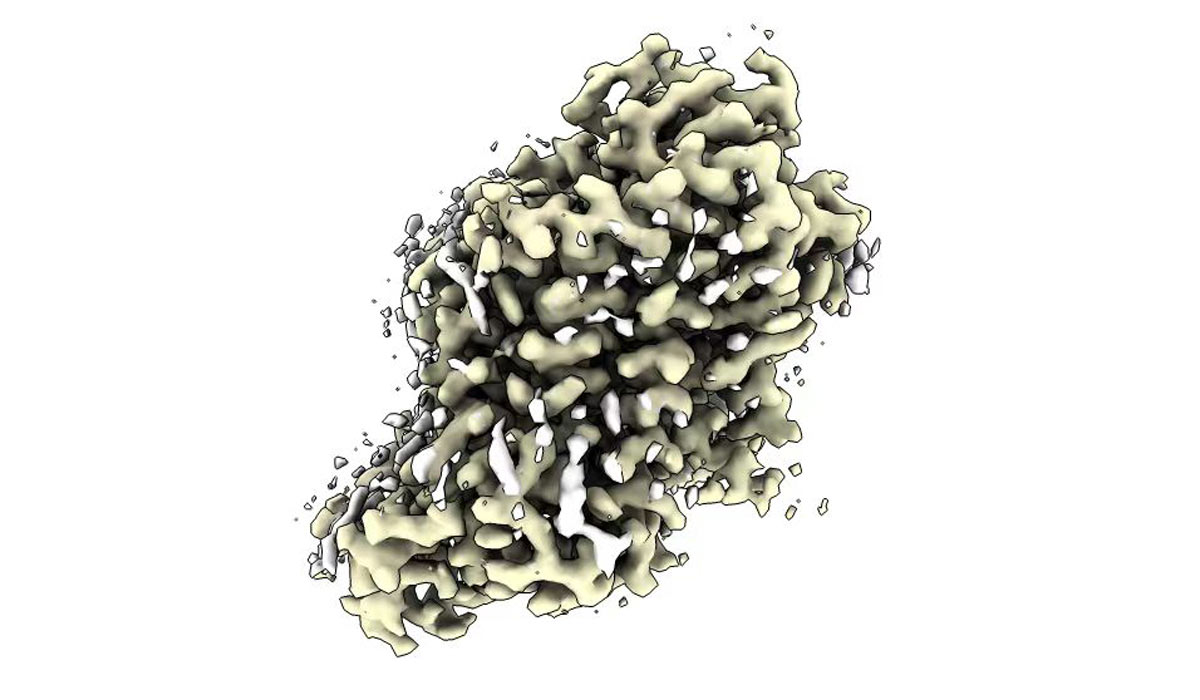Scientists have uncovered new details about how drugs to treat depression interact with a neurotransmitter key to sleep, concentration and stress.
Since their introduction in the 1950s, antidepressant drugs have helped millions of people find relief from depression and related conditions. But scientists still don’t fully understand the molecular mechanisms underlying their therapeutic effects.
In a new paper published in Nature, researchers at Tsinghua University have unveiled detailed 3D structures demonstrating how four common antidepressants work at the molecular level1.

A cryo-electron microscopy image of a protein known as a norepinephrine transporter, which helps regulate the neurotransmitter norepinephrine – a key player in processes that are vital to good mental health.
Chuangye Yan, an associate professor in the School of Life Sciences, and a co-author of the study, says these findings could lead to the development of better drugs for treating mental health disorders.
Fine levels of control
Yan and his colleagues focused mainly on the antidepressants’ interactions with one particular protein: the norepinephrine transporter. This transporter “is crucial for the brain”, says Yan, noting that the transporter molecule is responsible for keeping tabs on the neurotransmitter norepinephrine.
Neurotransmitters are chemicals that carry essential information across nerve cells. Norepinephrine , in particular, enables nerve cells to transmit information that helps us to fall asleep, concentrate, and deal with stress. Imbalances in norepinephrine levels can lead to a deterioration of physical and mental well-being.
The transporter is key to controlling levels of norepinephrine in the brain, because once norepinephrine has finished its job, the transporter jumps to action to capture and fetch it back to the neuron from which it was released2.
The norepinephrine transporter belongs to a class of molecules called ‘monoamine transporters’ — similar transporter molecules for the neurotransmitters dopamine and serotonin are also in this group.3
Some common antidepressants work by disabling monoamine transporters to increase neurotransmitter levels in the brain, which improves a person's mood and helps them function better.4 But these benefits are sometimes accompanied by side effects, says Yan.
Some people gain weight, experience reduced libido, or have trouble sleeping. “These drugs may also take weeks to become effective and do not work for everyone,” he adds.
To address the medicinal needs of around 280 million people grappling with depression worldwide , drugmakers need to urgently understand the molecular mechanisms behind antidepressants’ interactions with transporter molecules, especially the norepinephrine transporter. Studies elucidating the structures of these processes are scarce, so, Yan and his colleagues set out to change that.
Incredible detail
For the study, the researchers used cryo-electron microscopy (cryo-EM), which enabled them to study the structures of molecules inside a cell in tremendous detail.
When it comes to observing protein molecules such as the norepinephrine transporters that dwell on cell membranes, cryo-EM performs better than traditional methods such as X-ray crystallography, explains co-author Yafei Yuan, an assistant investigator at the School of Life Science at Tsinghua University.
With cryo-EM, the scientists captured images of norepinephrine transporter proteins attached to four antidepressants.

Chuangye Yan is an associate professor, and Yafei Yuan is an assistant investigator at the School of Life Sciences, Tsinghua University.
The 3D structures generated from the images provide invaluable insights into how four specific antidepressant drugs — atomoxetine, desipramine, escitalopram and bupropion — interact with the norepinephrine transporter at the molecular level.
These drugs are known to act on the norepinephrine transporter, but it wasn't clear how much of an effect they have. The researchers were keen to observe what's known as ‘selectivity’: In other words, is a particular drug primarily drawn to the norepinephrine transporter, or is the transporter the secondary target?
Atomoxetine, for example, has the strongest preference for the norepinephrine transporter, among various monoamine transporters. By zooming in on the norepinephrine transporter, the researchers could determine minor structural nuances in the protein that explained why certain antidepressants are more selective towards it.
Additionally, they discovered a second site on the norepinephrine transporter where norepinephrine is lodged and another spot where a potassium ion snugly lurks.
These findings “warrant attention from the pharmaceutical industry and researchers”, the authors wrote in their Nature paper. They noted that this study is an essential starting point, and more research is needed to investigate how antidepressants interact with other monoamine transporters.
References
1. Tan, J., Xiao, Y., Kong, F., Zhang, X., Xu, H. et al. Molecular basis of human noradrenaline transporter reuptake and inhibition Nature (2024). doi: 10.1038/s41586-024-07719-z
2. Zhou, J. Norepinephrine transporter inhibitors and their therapeutic potential Drugs of the future, 29(12), 1235–1244 (2004). doi: 10.1358/dof.2004.029.12.855246
3. Aggarwal, S., & Mortensen, O. V. Overview of Monoamine Transporters Current protocols in pharmacology 79, 12.16.1–12.16.17 (2017). doi: 10.1002/cpph.32
4. Harris, S., Green, S.M., Garber, L. & Urs, N.M. Regional Effects of Monoamine Transporter Blockers on Extracellular Monoamine Levels The FASEB Journal 34, 1-1 (2020). doi: 10.1096/fasebj.2020.34.s1.07137
Editor: Guo Lili